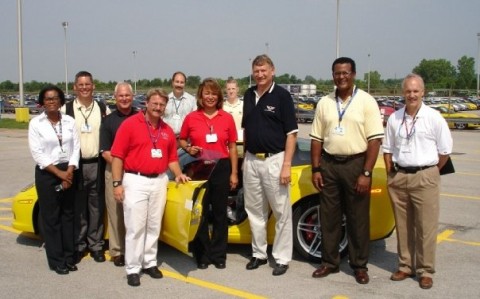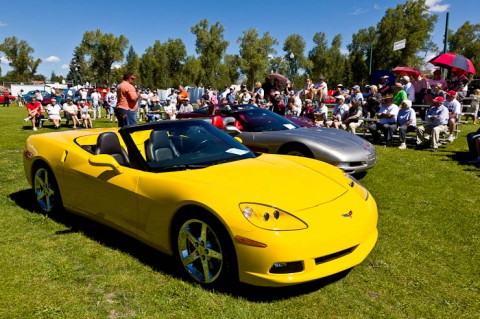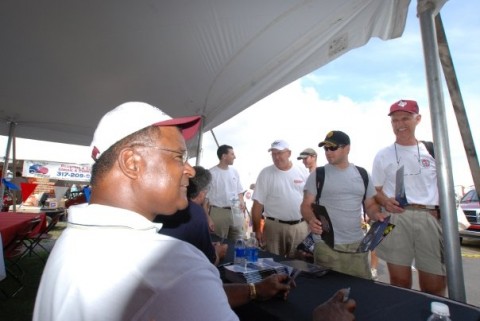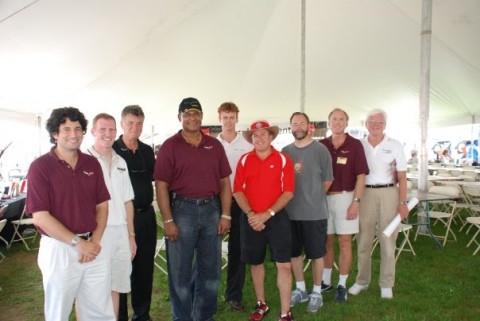We are continuing with another article (#2) from Wil Cooksey. This time Wil tells us about the C4 Corvette and the problems that needed to be addressed internally at the Corvette Assembly Plant..
Evaluating the Corvette C4
By Wil Cooksey
“The objectives we established for the Corvette were to maximize quality and to minimize costs and improve customer satisfaction.” -Wil Cooksey
When I arrived at Bowling Green, a good close look at the C4 revealed a number of quality issues that needed to be addressed. The C4 body panel fits lacked exact flushness to all the adjacent panels. In addition, side to side variation of fits on the car were not symmetrical and gaps were not uniform from end to end. Glass fit was all over the map. A careful inspection of the quality specifications found that many fits met the GM requirements. Specifications are written based on engineering and product requirements. Statistical variation usually means that you set a mean (average) target with plus and minus limits. If a process is allowed to operate in a controlled state, the end results will be + or – in variation. Given specifications written as the fit should be 2mil + or – 1 mil means that if the measured value falls between 1 mil and 3 mil then the fit meets specifications. What this means is that the flushness would be in specs if the difference is 3 mil from panel to panel.
 Wil and Joe Spielman with the Corvette Plant team.
Wil and Joe Spielman with the Corvette Plant team.
Customers do not know specs and could care less. What they want is flushness, even small gaps, no V or A gaps. What is meant by the term “V” and “A” gap? An “A” gap is defined by observing that the gap is closer at the top than at the bottom. A “V” gap is smaller at the bottom of the gap and wider at the top.
My philosophy on customer satisfaction is simple….give the customer more than is expected. If the specification is flush +/-..Our process will finesse to flush on all panels. A and V gaps will be finessed to parallel on all gaps. Finesse adds hours per vehicle to the manufacturing costs but the customer gets the benefit until a better way to satisfy the customer is developed.
GM paint specs on paint takes into consideration that certain zones on the car are more visible and should be more defect free than other zones. The trouble with that concept is that Corvette owners want the entire car to be show car ready. That means that all paint defects must be addressed. Initially, the cost to do this will increase until you find a better way to get perfect panels.

Wil speaking to Corvette enthusiasts in Gunnison, CO.
Squeaks and rattles are difficult to address. Specs are that you are not allowed any squeaks and rattles. That means that you must pay close attention to determine exactly where the noise is coming from and put process and/or engineering changes in place to eliminate the problem. The ultimate test is to demonstrate you have correctly identified the issue by turning the problem on and off. Normal areas that you work on is in the top panel, instrument panel, door glass, and interior trim panel.
Door opening and closing efforts can be affected by door fit to the opening, glass fit to the door and the relationship of the weatherstrip to the door/glass. The interior of the Corvette is almost air tight except for one vent in the rear tub. If you slam the door aggressively you will get some push back as the air exhausts from the interior. We always felt that going to indexing glass could help with this problem. Later we did make this change in the C6.
Hood fits and closing efforts were improved on the C4. The Clamshell hood was well liked in that the design line where a fit may be observed is at the body side molding area. Front and rear fascia fits appeared to be lower priority than door and glass fit. Water leaks are always difficult to analyze so being systematic and methodical proves beneficial in problem solving. The Red X problem solving process has been quite helpful in resolving those issues.

Wil at the autograph table talking to customers
Sometimes issues will occur when all aspects of variation are not considered during the vehicle development process. Let’s look at the carbon fiber hoods as an example; Engineering design wants a
carbon fiber hood for the Corvette. The technology is not new so you have a starting point. You look at the marketplace to review carbon fiber hoods already being produced .After a review of available hoods the decision is made to select a manufacturer to produce the new Corvette hood. You later find that existing quality of carbon fiber hoods is unacceptable by Corvette standards. Test runs to determine what changes need to happen to meet Corvette finish product standards are run at the supplier and Corvette plant. After all quality issues have been resolved, final tooling rates must be determined. First time quality yield off the tooling is very important. High quality means that you can invest in less duplicate tooling.
Russ McLean, Corvette Program Manager, was very instrumental in developing the vehicle development problem solving process used in headquarters, Warren Michigan and the assembly plant.
On line reviews were done on an ongoing basis. Engineers and assembly workers were asked to document all issues important to the quality build of the vehicle. Each area of build contained an easel with all issues noted. Weekly walks by the Corvette team addressed progress or lack of progress on the issues. You also talked to the person assembling the product and asked for any ideas they may have to do a better job of assembly. This process really created a sense of urgency for solving problems both in the plant and at the prototype shop in Detroit.
The vehicle development process that we continued to use involved getting all the Corvette team players together and discussing what the proposals were to build the next generation of Corvettes. The process works extremely well when all parties have mutual respect for each other’s point of views on how each party is involved in the new product. For example, if the field service engineers says that the vehicle design does not allow Mr. Goodwrench to do the repair without taking the engine out of the car. The manufacturing person may have a concern that the assembly process person cannot do the job with ordinary size hands.

Wil and the Corvette team at Corvettes at Carlisle
The 1990-1995 ZR1 and the 1996 Grand Sport and Collector’s Edition benefited from appropriate use of the VDP (vehicle development process). The ZR1 was a great vehicle that experienced over pricing since the option was $25,000 over the regular base price. A host of extra content went into the vehicle. What I believe hurt the sales more than anything was that the base Corvette looked too similar to the ZR1 option such as wide body panels, wider tires etc. To see a base Corvette and a ZR1 optioned from a distance you could not detect a difference. Not many people wish to pay $25,000 extra for a Corvette and have it look like a base Corvette. If making the base Corvettes look similar to the ZR1 will help you sell more base Corvettes then maybe it’s worth it to take away from your expensive model (ZR1) . That generally is not the case and in 1995 the last ZR1 rolled off the line.
The 1996 Grand Sport and the Collector’s Edition are two of the best C4’s ever made. The 5th generation was scheduled to debut in 1997 and everyone on the vehicle development team and the launch team wanted to make sure that the 1st new generation Corvette is as good or better than the last generation it replaced. The Grand Sport paint scheme, with the white stripe down the center, was more of a challenge than we anticipated. Originally, we had planned to use decals as much as possible and paint the Admiral Blue and use white decals to finish the paint scheme. The team decided that to get the quality it wanted on the Grand Sport that the white stripe would be painted and then the admiral blue painted on last on the rest of the car. This process proved to be the most challenging from a repair and finesse standpoint.
The 1995 Indy Pace Car was also a difficult one from a paint scheme standpoint. The vehicle two-tone paint was accomplished by running each car through the paint process two times. One color was shot on each pass through the system. A paint process dependent on two passes through the system reduces overall throughput capacity. This is unacceptable in most cases.
Historically customers have heard that the vehicles produced as the first production units in a new model would not have as good a quality as those vehicles produced later in the production schedule.
Our efforts on quality have driven us to develop more robust design and assembly processes. The quality system should never be compromised. The system is not dependent on the day of the week to be effective. Defects are not to be passed on to the next work station. First time quality is measured in real time and if the operator feels that the line needs to stop to correct the item then the operator calls for help and if help does not arrive the line will stop.

Wil and Steve Grilli speaking to enthusiasts at Corvettes at Carlisle
Every time I look at where we are today I can’t help but remember what I saw when I arrived at the Bowling Green Assembly Plant, February 1, 1993. My first observations saw an organization working hard to show GM that it deserved the next generation Corvette C5. Management and UAW were working hard to be one team willing to do whatever needs to be done to be successful and to retain all jobs. The culture was headed toward a team environment. A master dot planning process was put into place to capture all the work that needs to be done to have a successful product launch process.
In order to change the culture of an organization requires some special training for all employees. Training plans were developed to help all employees be empowered to get involved with everything from how the product builds on the assembly line to setting quality standards for outgoing customer satisfaction. The assembly worker learns how to set jobs on the line up to operate effectively. Value added means that parts are being assembled to the car. Non value is work being done other than putting parts on the car.
As Plant Manager , I reported to Jack Evans, Regional Manager, for the Corvette plant. My biggest challenge was to keep him informed of what my assessment was of the state of non- competitiveness that exists at the plant. The plan for change was developed over time and implemented in a timely manner. Changing the work environment is not an easy task. I preferred to make my own observations and act upon them over a finite time period. Corporate product allocation decisions are made based on the quality repetition and cost of manufacturing. UAW and GM plant employees were told that if no improvement is made that there is a 95% chance that the C5, the next generation, would be built in one of our plants outside Bowling Green, Kentucky. Jack Evans wanted everything to change very quickly and at times got into my way when he and I had different ideas about how to change the organization. My request to him was to let me do it my way and if that didn’t work then he could replace me.
Tradition had always been to move a plant manager into the Corvette plant manager’s job every 2 to 3 years. I do not feel that allows the manager to be accountable for his actions. My tenure as manager for 16 years was not the norm. I have experienced change across three generations C4, C5, and C6. The many awards given over time speak for themselves as to the plant manager’s value of tenure.

Wil, Mike Yager and the Corvette team at Corvettes at Carlisle
Project 96 was a plan developed by the Corvette team to address issues of non-competitiveness. To a large extent, the plan contained more work issues than the team knew how to handle. Further investigation required a redo of the plan. This time we introduced the Master Dot planning process. This process is very similar to Microsoft Project. Planning components were identified and names were assigned to each component. Regular follow- up meetings were held and progress recorded. If a due date was missed, then the assignee had to come up with a recovery plan. Holding each of us accountable for each event yielded excellent results. The team helped each other accomplish our tasks.
A review of our plan with Don Hackworth, Group Vice President of Manufacturing, was quite lively. Don soon realized that the
Bowling Green Assembly plant was up for the challenge of building the C5. The new design was a result of many hours of work in the VDP. The problems experienced with C4 were addressed on the new design. Don designated me as the final word when it came to determining if the plant was ready to ship new Corvettes to the customers. This authority had never been given to a plant manager. My philosophy is that each year’s Corvette must be better than the previous years. All known problems must be addressed before the new model is produced.
A wish list was developed for what we wanted to see improved on
C5. The partial list is as follows;
- Door glass fit
- Headlight door fit
- Deck fit
- Fender fit
- Cup holder
- Deck lid pull down
- Step over entry
- Instrument panel fit
- Tail light fit
- Roof panel fit
Some of you may ask “ How do you determine where to start, when you have a list so long?” My answer is to prioritize the list in terms of customer dissatisfaction. The loudest voice of the customer is where you need to start. My information comes as a result of talking to hundreds of Corvette enthusiasts. Each year I made sure that my staff and I schedule Corvette events that we will attend. Our list of events to visit include events such as events held at the NCM, Corvettes at Carlisle, Funfest, Bloomington Gold etc..
The C4 was designed to make a giant step forward in meeting customer requirements. The voice of the customer demanded that a number of improvements be made from their experience with the C3. The clam shell style hood was a favorite of those owners who like to present their cars in car shows. The engine compartment is easy to clean and show. The fits and finish was improved but not perfected. Squeaks and rattles were a real challenge to eliminate. Water leaks were reduced but not eliminated entirely. The instrumentation was a real hit and the interior fits were less than spectacular. Many customers complained about the step-over threshold and drop to the seats. The foot well was more narrow than expected. My size 15 shoes were cramped in the foot well. Inspite of all of this… I am the proud owner of a 40th Anniversary Corvette….
Until next time…
